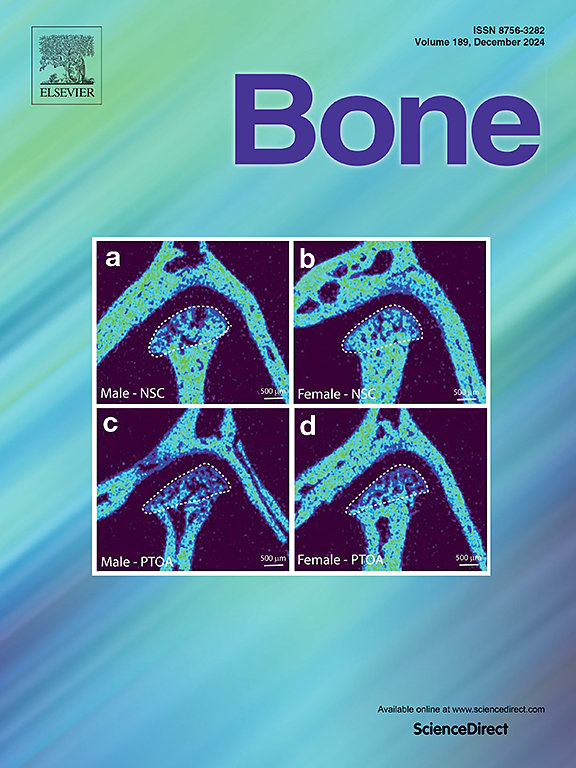Different effects of moderate tibial loading and Yoda1 on breast cancer-induced osteolysis in aged mice
IF 3.5
2区 医学
Q2 ENDOCRINOLOGY & METABOLISM
引用次数: 0
Abstract
Elderly breast cancer patients and survivors are at high risk of bone loss but experience obstacles to harness the known benefits of exercise due to aging, cancer, and cancer treatment. Previously, we and others showed that moderate mechanical loading suppressed breast cancer-induced osteolysis in young adult mice. To overcome the mechano-transduction deficits in aged skeletons, we recently tested a dual therapy combining mechanical and Yoda1 activation of mechanosensitive Piezo1 channels. We found that the dual therapy was more effective in mitigating bone loss due to aging and doxorubicin in mature mice than the individual interventions. In the present study, we further tested the hypothesis that dual therapy combining moderate tibial loading and Yoda1 protects aged skeleton from breast cancer-induced osteolysis better than individual treatments. Aged female C57BL/6 J mice (~74-week-old) receiving Py8119 breast cancer cells in both tibiae were assigned to the four experimental groups (n = 5–8 per group) to examine the effects of 4-week Yoda1 (dose 5 mg/kg, 5 times/week) and moderate tibial loading (4.5 N peak load, 4 Hz, 300 cycles per day, 5 days/week), individually or combined on bone structural integrity. At the end of 4 weeks' experiments, the dual therapy group had the lowest incidence of osteolytic perforation (56 %) compared to the non-treated group (80 %), loading only group (70 %), and Yoda1 only group (100 %). The relative drop of cortical polar moment of inertia (Ct.pMOI), calculated as [(Week 4- Week 0)/Week 0, %], were analyzed at the proximal end, mid-diaphysis, and tibial-fibular junction of the tibia. The average values over the three locations were − 12.7 %, −3.2 %, −24.0 %, −4.2 % for the non-treated, loading only, Yoda1 only, and dual therapy groups, respectively. Furthermore, the % of samples with decreased Ct.pMOI (indication of structural deterioration) was suppressed in the dual therapy group (33 %), compared with nontreated (100 %), loading only (80 %), and Yoda1 only (100 %) groups. Each treatment differentially affected the osteoclast activity, tumor proliferation, and apoptosis of osteocytes, marrow cells and tumor cells, revealing the complex interactions of bone, tumor, and mechanical stimulations. In summary, the dual therapy resulted in skeletal benefits comparable to or slightly better than loading only treatment. However, the exacerbated bone loss and cortical perforation associated with Yoda1 call for further investigation on safe and effective treatments of skeletal damages caused by metastatic breast cancers.

适度胫骨负荷和Yoda1对老年小鼠乳腺癌诱导的骨溶解的不同影响
老年乳腺癌患者和幸存者骨质流失的风险很高,但由于衰老、癌症和癌症治疗,他们在利用运动的已知好处方面遇到了障碍。之前,我们和其他人发现适度的机械负荷抑制了年轻成年小鼠乳腺癌诱导的骨溶解。为了克服老年骨骼的机械传导缺陷,我们最近测试了一种结合机械和Yoda1激活机械敏感的Piezo1通道的双重疗法。我们发现,与单独干预相比,双重治疗在减轻成熟小鼠因衰老和阿霉素引起的骨质流失方面更有效。在本研究中,我们进一步验证了联合适度胫骨负荷和Yoda1的双重治疗比单独治疗更能保护老年骨骼免受乳腺癌诱导的骨溶解的假设。将接受Py8119乳腺癌细胞的老年雌性C57BL/6 J小鼠(~74周龄)分为4个实验组(每组 = 5 - 8只),分别观察4周Yoda1(剂量5 mg/kg, 5次/周)和适度胫骨负荷(4.5 n峰值负荷,4 Hz, 300 周期/天,5 天/周)对骨骼结构完整性的影响。4 周实验结束时,与未治疗组(80 %)、单纯负荷组(70 %)和单纯Yoda1组(100 %)相比,双重治疗组溶骨穿孔发生率最低(56 %)。皮质极惯性矩(Ct.pMOI)的相对下降,计算为[(第4周-第0周)/第0周,%],分析胫骨近端、骨干中部和胫骨-腓骨交界处的相对下降。三个位置的平均值分别为 − 12.7 %,−3.2 %,−24.0 %,−4.2 %,分别为未治疗组,仅加载组,仅Yoda1组和双重治疗组。此外,样品中Ct值降低的百分比。与未治疗组(100 %)、仅加载组(80 %)和仅Yoda1组(100 %)相比,双重治疗组(33 %)抑制了pMOI(结构恶化迹象)。每种处理对破骨细胞活性、肿瘤增殖和骨细胞、骨髓细胞和肿瘤细胞凋亡的影响不同,揭示了骨、肿瘤和机械刺激之间复杂的相互作用。综上所述,双重治疗对骨骼的益处与单纯负重治疗相当或略好。然而,与Yoda1相关的骨质流失和皮质穿孔加剧,需要进一步研究转移性乳腺癌引起的骨骼损伤的安全有效治疗方法。
本文章由计算机程序翻译,如有差异,请以英文原文为准。
求助全文
约1分钟内获得全文
求助全文
来源期刊

Bone
医学-内分泌学与代谢
CiteScore
8.90
自引率
4.90%
发文量
264
审稿时长
30 days
期刊介绍:
BONE is an interdisciplinary forum for the rapid publication of original articles and reviews on basic, translational, and clinical aspects of bone and mineral metabolism. The Journal also encourages submissions related to interactions of bone with other organ systems, including cartilage, endocrine, muscle, fat, neural, vascular, gastrointestinal, hematopoietic, and immune systems. Particular attention is placed on the application of experimental studies to clinical practice.
 求助内容:
求助内容: 应助结果提醒方式:
应助结果提醒方式:


